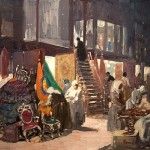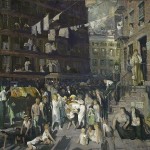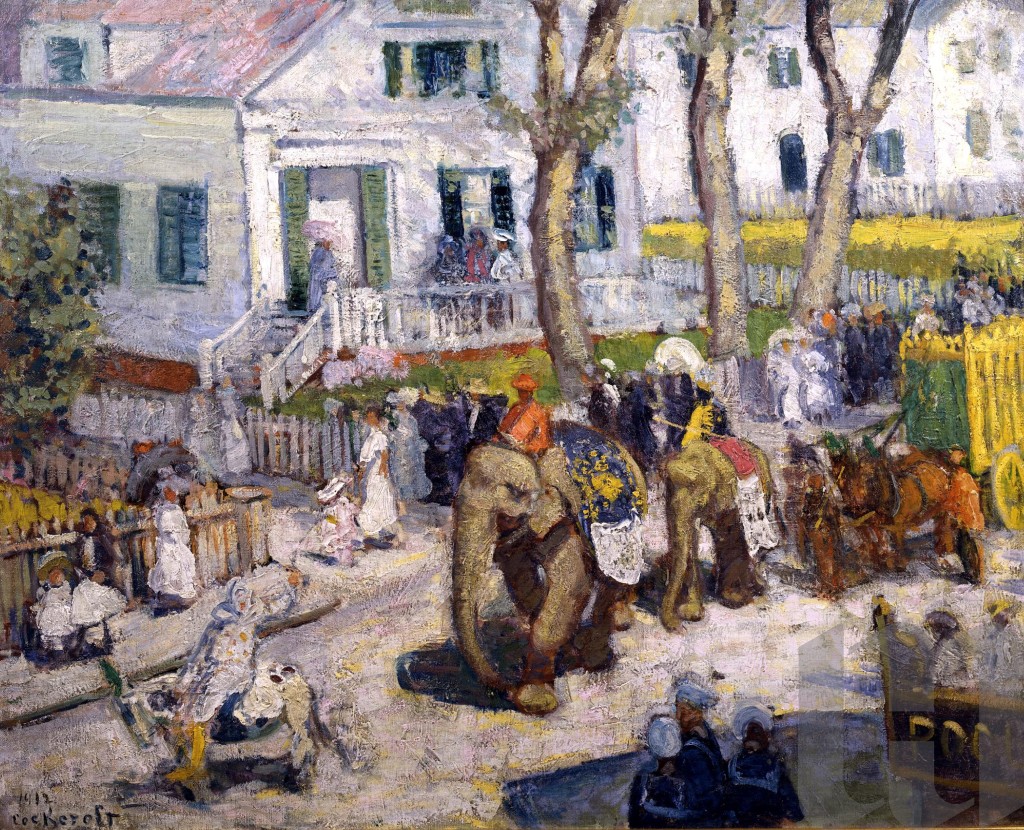
Edith Cockcroft, “The Circus is in Town”, 1912 , The Hunter Museum of American Art
Edith Cockcroft, though not well known today, was an established and successful artist in her time. “The Circus is in Town”, part of the Hunter Museum of American Art’s permanent collection, is one of her paintings from 1912, done when she was 31 years old. In it, a circus has come to a small New York town and the locals have turned out to view the parade announcing its arrival. It is, no doubt, a regional circus, a mere shadow of the splendor of Ringling Bros. It’s probably been to this little town on more than one occasion. Still, though all but the youngest townsfolk know what to expect, it’s a bit of a novelty in its way and something to be welcomed. A cursory glance tells us we have a bit of Americana here, a display of the innocent joy of small town living.
Perhaps. But I think more is going on if one looks carefully and is aware of the context.
To begin with, Edith Cockcroft is painting in, what was for the time, a modern and controversial style. The idea of a turn of the century circus arriving in a small town suggests sentimental nostalgia– a motif beloved by the illustrators of the time. She, however, approaches her subject objectively and with a technique that is rough, spontaneous, and dynamic.
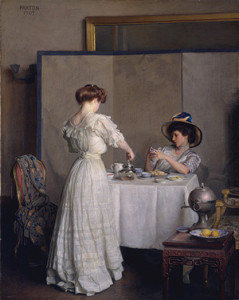
William McGregor Paxton, “Tea Leaves” 1909–Metropolitan Museum of Art
Just four years earlier, in 1908, a now famous exhibition by eight artists, later dubbed by critics “The Ashcan School,” had been staged at the Macbeth Gallery in New York. At that time, it was the only gallery in the city that showed contemporary American art. Presented by the artists Robert Henri, John Sloan, George Luks, Edward Shinn, William Glackens, Arthur Davies, Maurice Penderghast, and Ernest Lawson, the show was roundly condemned by critics for its unacceptable and unpleasant subject matter (streetlife, tenements, etc.) and coarseness of style. Though massive changes in art had already occurred in Europe, most notably in France, the American art schools still clung steadfastly to a narrow academic style that one challenged at one’s peril. The academics set and maintained very conservative standards, and, as the twentieth century began, America was largely an artistic backwater.
The show mounted by the eight artists of the Ashcan School was a direct challenge to this state of affairs. Edith Cockcroft would have understood and sympathized with their cause. Certainly, the young Ms. Cockcroft possessed artistic sophistication. Born in 1881 in Brooklyn, NY, she went to France in 1898, spending the next several years in the art colonies of Pont Aven and Concarneau. While living in Paris, she studied with Henri Matisse and exhibited at the Société Nationale des Beaux-Arts and the Salon d’Automme. Returning to the United States her work was exhibited at the National Academy of Design from 1910 to 1915, as well as at the Art Institute of Chicago, the International Art Union, the Salons of America, the Pennsylvania Academy and the Corcoran Gallery. Hardly someone with a narrow or provincial mindset, Edith Cockcroft was an artist who had her finger on the pulse of the avant garde.
- Robert Henri, “Snow in New York”, 1902 — National Gallery of Art
- George Luks, “Allen Street”, 1905– Hunter Museum of American Art
- George Bellows, “Cliff Dwellers”, 1913 –Los Angeles County Museum of Art
So what is she up to in this painting of small town American life.
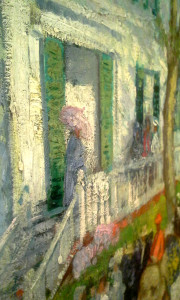
“The Circus is in Town” (Detail)
To my mind, this painting is a sly critique of contemporary American life and culture, somewhat akin to that in Sinclair Lewis’s 1920 novel, Main Street. Her use of such a rough, spontaneous technique would, to the viewer of the time, be a bit like our hearing the Rolling Stones do a cover of “A Bicycle Built for Two”. The paint surface contrasts with the subject in a way that underscores the provincialism of the setting.
And there is further evidence of her intent.
Look at how she uses her palette. All the color is centered on the circus. Cover the lower quarter of the canvas and the remainder goes utterly lifeless and bland. The orange figure on the elephant demands our eye’s attention. More color dances along along behind, but almost no color is given to the houses or the people in the small town. They may be the bedrock of the nation, but they are also empty, static, and drab. Color, movement, and excitement must come from elsewhere.
So is it too much of a stretch to go from there to wondering if the circus just might represent the new young artists and their work? Artists and ideas she knew were coming that would utterly change American art forever. Edith Cockcroft had been to Paris, had met the avant garde, had seen the future. Was she subtly telling the rest of her country that they would soon experience it, too? All of the speculations above are obviously my personal reaction to her painting. We will never know exactly what Edith Cockcroft’s intentions were, but I would like to think that is exactly what she was doing.
Edith Cockcroft spent her entire adult life as an artist, not giving up her career for her husband (very common at the time), though she married and lived in New York City and then in Sloatsburg, New York. Her husband, Charles Weyand, was a stock broker who was ruined by the stock market crash of 1929 and the ensuing Depression. It was Edith who then supported them with her pottery, jewelry and fabric designs.
Let us savor that for a moment—an artist supporting a failed stockbroker! For that alone Edith Cockcroft deserves to be remembered.
She died in Ramapo, NY in 1962.
.

